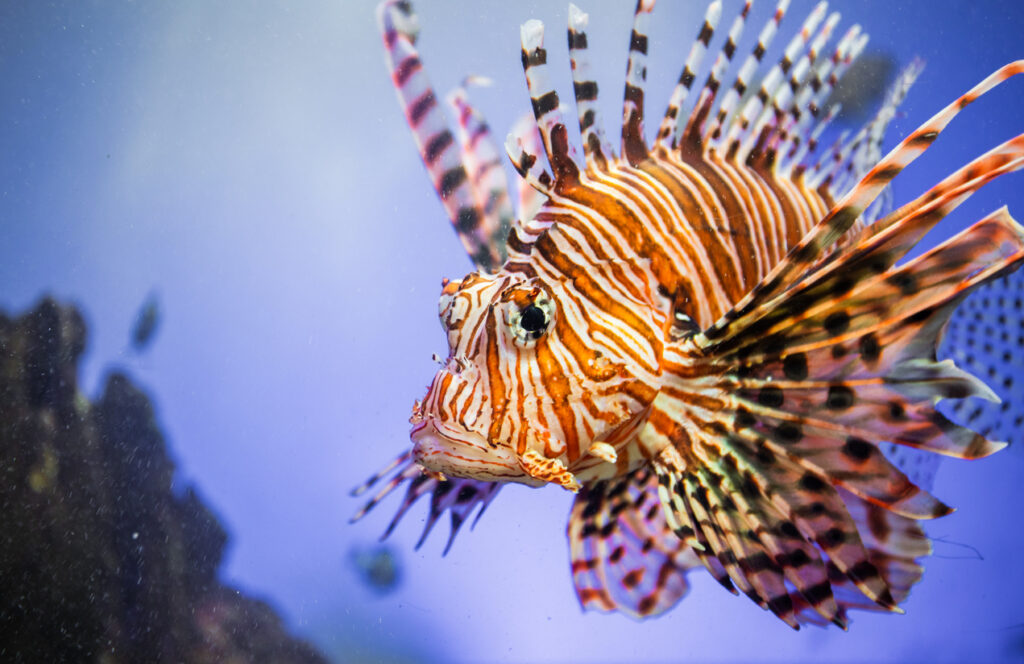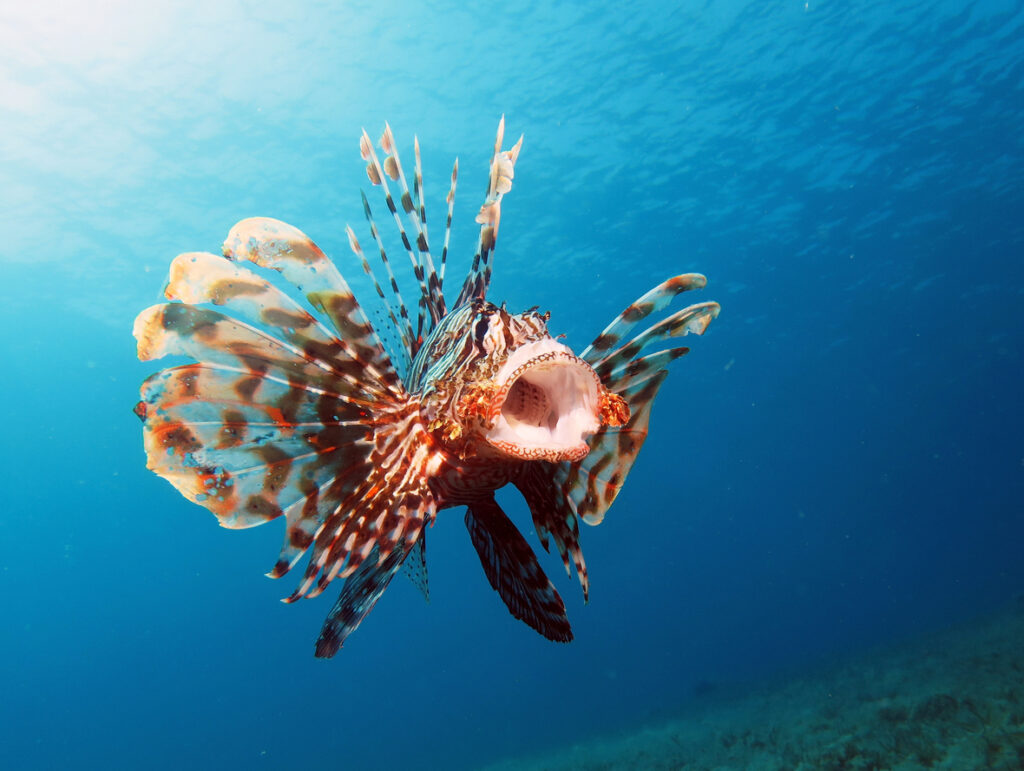Few fish are as striking to look at and as intimidating to learn about as the lionfish (Pterois spp). These otherworldly marine creatures look tough and are tough, with venomous spines, incredible camouflage, and surprisingly quick reflexes that make them one of the top predators among the coral reefs of the Indo-Pacific Ocean.
Of course, all these attributes and more mean the lionfish is a super popular animal to see here at Blue Planet Aquarium. Our resident red lionfish (Pterois volitans) is the centrepiece of Venom, where you can get up close to some of the deadliest critters known to man.
Before you brave Venom, we thought it was worth taking a minute or two to get you up to speed on the mighty lionfish – from where it lives to the potency of its venomous spines.
What is a lionfish?
The lionfish is genus of venomous fish that are native to the Indo-Pacific Ocean. There are currently 12 known species of lionfish in the Pterois genus, including:
- Andover lionfish (Pterois andover)
- Spot-fin lionfish (Pterois antennata)
- Red Sea lionfish (Pterois cincta)
- Luna lionfish (Pterois lunulata)
- Devil firefish (Pterois miles)
- African lionfish (Pterois mombasae)
- Pterois paucispinula
- Clear-fin lionfish (Pterois radiata)
- Russell’s lionfish (Pterois russelii)
- Hawaiian turkeyfish (Pterois sphex)
- Red lionfish (Pterois volitans)
Lionfish, along with stonefish (Synanceia) are part of the wider Scorpionfish (Scorpaenidae) family, all members of which are characterised by their sharp, venom-coated spines. There are hundreds of unique genus of Scorpaenidae, with most species preferring warm, temperate and tropical waters.
What does a lionfish look like?
Pretty scary, that’s what! Of course, they’re supposed to be.
The whole reason that lionfish look so intimidating is to deter would-be predators. And it seems to be working, as these fish are pretty top of the food chain wherever they’re found in the world’s tropical waters.
When you see a lionfish, it becomes pretty clear where these predatory tropical fish get their name. With their heads encircled by a “mane” of fleshy spines, fan-like pectoral fins, and long, deadly dorsal spines, they look every bit as fearsome as their namesake big cat.

And it isn’t just this unique ring of appendages that gives the lionfish its menacing appearance. Most species are red, brown, or maroon in colour, with distinctive stripes and markings that seem to scream “danger”. They’re also pretty large, particularly when you take into account the length of their 13 long dorsal spines, with fully-grown red lionfish growing to an average size of around 40cm across.
Where do lionfish live?
All species of lionfish are native to the warm, tropical waters of the Indian and Pacific Oceans, so you could expect to see one from the Great Barrier Reef to the shores of Madagascar. As bottom-dwellers, these fish live in water depths from one to 100 metres, but are most commonly found at a depth of around 20 metres.
Sadly, some species of lionfish, particularly Pterois volitans, are now considered invasive in many seas and oceans throughout the world. Their presence in the Caribbean Sea, the Atlantic Ocean, and the Mediterranean Sea is attributed to a decline in the number of some fish, with their population impossible to control due to the lack of natural predators. As such, fishermen and hobbyists alike are encouraged to actively search for and catch lionfish wherever they’re found beyond their native range.
Venom of a lionfish: How dangerous is it?
As soon as we hear the term “venomous”, we humans have a tendency to recoil in fear. But while the lionfish is, indeed, classed as venomous fish, it doesn’t use its natural toxicity as a means of preying on other fish – or attacking us!
The venom of lionfish is used purely as a form of defence. It coats the 13 dorsal spines of the fish, deterring predatory species from seeing the animal as their next meal.
While lionfish venom is toxic enough to kill some species of fish, it’s not fatal to humans. It is, however, pretty harmful, causing localised pain, swelling, redness, and in extreme cases, paralysis, necrosis, and convulsions. Yikes!

Habits and behaviour
Lionfish are nocturnal predators, with all species most active at night. They tend to hide in crevices on the seafloor during the day, keeping well out of sight of potential predators.
Most species of lionfish, including Pterois volitans, are solitary, seeking the company of other lionfish only when it’s time to breed. Typically, a male lionfish will court and breed with numerous female lionfish at once, which is known as a harem of females. The females are capable of laying around 30,000 eggs per mating cycle – and up to 2,000,000 eggs every year.
For their size, lionfish are considered a relatively long-lived species, with an average lifespan of 20 years in the wild and longer in captivity. This relatively long life expectancy, coupled with the rate at which they reproduce, is part of the reason why some lionfish have become such a problem as an invasive species.
Predators and prey
Lionfish are not fussy when it comes to food. These prolific and opportunistic hunters will dine out on everything from small fish to invertebrates and molluscs, and with a voracious appetite, are known to eat multiple times a night.
While they may appear cumbersome, lionfish are skilled hunters. They use their fleshy appendages, fins and spines to corner their prey, before swallowing it whole with their wide mouths. And, when cornering doesn’t work, they have a few additional tricks up their sleeve to aid efficient predation – from a specialised swim bladder that makes them remarkably agile, to the ability to blow jets of water that confuse and disorientate their prey.
As for predators; in their natural habitat, lionfish are preyed on by several species, including tiger groupers (Mycteroperca tigris), moray eels (Muraenidae), and several species of sharks.
We hope you’ve enjoyed this guide on everything there is to know about the fearsome but beautiful lionfish. For an up-close encounter with this intimidating creature of the deep, book your tickets to Blue Planet Aquarium to experience our Venom exhibit for yourself.
